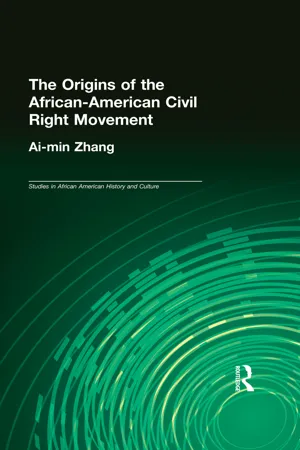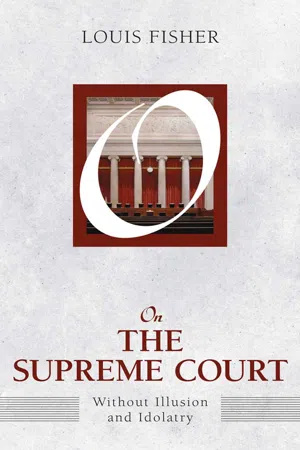Civil Rights Acts of 1866
The Civil Rights Act of 1866 was the first federal law to define citizenship and affirm that all citizens were equally protected by the law. It granted citizenship and the same rights to all people born in the United States, regardless of race or previous condition of servitude. The act aimed to counter the discriminatory Black Codes and lay the groundwork for future civil rights legislation.
6 Key excerpts on "Civil Rights Acts of 1866"
- eBook - ePub
Creating U.S. Democracy: Key Civil Rights Acts, Constitutional Amendments, Supreme Court Decisions & Acts of Foreign Policy (Including Declaration of Independence, Constitution & Bill of Rights)
The Most Important Legal Documents, Established Principles & Crucial Court Cases Which Built the America as We Know It
- U.S. Government, U.S. Supreme Court, U.S. Congress(Authors)
- 2017(Publication Date)
- Madison & Adams Press(Publisher)
...The Civil Rights Act of 1866 Table of Contents AN ACT SECTION II SECTION III SECTION IV SECTION V SECTION VI SECTION VII SECTION VIII SECTION IX SECTION X PRESIDENTIAL VETO VETO OVERRIDE AN ACT Table of Contents To protect all Persons in the United States in their Civil Rights, and furnish the Means of their Vindication Be it enacted by the Senate and House of Representatives of the United States of America in Congress assembled, That all persons born in the United States and not subject to any foreign power, excluding Indians not taxed, are hereby declared to be citizens of the United States; and such citizens, of every race and color, without regard to any previous condition of slavery or involuntary servitude, except as a punishment for crime whereof the party shall have been duly convicted, shall have the same right, in every State and Territory in the United States, to make and enforce contracts, to sue, be parties, and give evidence, inherit, purchase, lease, sell, hold, and convey real and personal property, and to full and equal benefit of all laws and proceedings for the security of person and property, as is enjoyed by white citizens, and shall be subject to like punishment, pains, and penalties, and to none other, any law, statute, ordinance, regulation, or custom, to the contrary notwithstanding. SECTION II Table of Contents And be it further...
- eBook - ePub
- William J. Rothwell, William J. Rothwell(Authors)
- 2012(Publication Date)
- Pfeiffer(Publisher)
...ARTICLE 19 CIVIL RIGHTS ACTS Emily R. Wilkins Definition of Legislation The Civil Rights Act of 1964 was enacted July 2, 1964, and was signed by President Lyndon B. Johnson. It was a revolutionary piece of legislation in the United States. The Civil Rights Act banned major forms of discrimination against blacks, including racial segregation, and women (The Dirksen Congressional Center, 2006). The Civil Rights Act was initially established by President John F. Kennedy, and its intention was to end the racial gaps between blacks and whites in the United States. The political and social climate attributed to the creation and development of the Civil Rights Act. Overview of Civil Rights Act The key components of the Civil Rights Act of 1964 were 1. Barred unequal application of voter registration requirements, but did not abolish literacy tests sometimes used to disqualify African Americans and poor white voters. (The Dirksen Congressional Center, 2006) 2. Outlawed discrimination in hotels, motels, restaurants, theaters, and all other public accommodations engaged in interstate commerce; exempted private clubs without defining “private,” thereby allowing a loophole. (The Dirksen Congressional Center, 2006) 3. Encouraged the desegregation of public schools and authorized the U.S. Attorney General to file suits to force desegregation, but did not authorize busing as a means to overcome segregation based on residence. (The Dirksen Congressional Center, 2006) 4. Authorized but did not require withdrawal of federal funds from programs which practiced discrimination. (The Dirksen Congressional Center, 2006) 5. Outlawed discrimination in employment in any business exceeding twenty five people and creates an Equal Employment Opportunity Commission to review complaints, although it lacked meaningful enforcement powers...
- Ai-min Zhang(Author)
- 2014(Publication Date)
- Routledge(Publisher)
...In order to reinforce its war fruits and its political domination, with an alliance of Republicans in the North and some radical Democrats in the South, the U.S. Congress passed between 1866-1875 a series of acts and two Amendments to the Constitution. 1 For example, "An Act to Protect all Persons in the United States in their Civil Rights, and Furnish the Means of their Vindication," was adopted by the Congress on March 13, 1866 and was vetoed by President Andrew Johnson and passed again on April 9 of the same year; the second Civil Rights Act passed on May 21, 1866 was designed to prohibit kidnapping blacks to force or sell them to be slaves; "An Act to abol ish and forever prohibit the System of Peonage in the Territory of New-Mexico and other Parts of the United States" passed on March 2, 1867; the Mandated Enforcement Act of May 31, 1870; the Ku Klux Klan Act was adopted on April 20; the acts enacted by the Congress respectively on March 2,1870 and June 26, 1873 providing that "the respected" passengers should be received in the hotels and other public accommodations regardless of their race and color of skin in Washington D.C.; the Civil Rights Act of 1875, which provided African Americans' equal economic, political, and social rights, was passed on March 1,1875. Of special importance was the passing into law of the Fourteenth and the Fifteenth Amendments to the U. S. Constitution, which legally acknowledged and protected the African Americans' basic rights. The Fourteenth Amendment, passed on July 28, 1868, enacted three extremely important articles, i.e. "privileges or immunities," "Due process of law," and "Equal protection of laws." These had a very significant impact on the later social life and destinies of African Americans', and they also provided that the Federal government was empowered to enforce the various acts. The Fifteenth Amendment, passed on March 30, 1870, was designed to protect the right of African Americans to vote...
- Kasper Lippert-Rasmussen, Kasper Lippert-Rasmussen(Authors)
- 2017(Publication Date)
- Routledge(Publisher)
...The equality proposed in that section was explicitly comparative. Like God instructing Moses on sacrifices, the Fourteenth Amendment (according to its proponents) instructed the states: Whatever law punishes a white man for a crime shall punish the black man precisely in the same way and to the same degree. Whatever law protects the white man shall afford “equal” protection to the black man. Whatever means of redress is afforded to one shall be afforded to all. Whatever law allows the white man to testify in court shall allow the man of color to do the same. (Congressional Globe 1866: 2459) This instruction was necessitated by the immediate post-war condition in the South, where, asserted one defender of the Amendment, color disqualifies a man from testifying in courts, or being tried in the same way as white men. I need not enumerate these partial and oppressive laws. Unless the Constitution should restrain them, those States will all, I fear, keep up this discrimination, and crush to death the hated freedmen. (Congressional Globe 1866: 2459) President Andrew Johnson, who succeeded to the office after Lincoln’s assassination, assumed a substantial place in the Congressional debates, excoriated by Republicans and defended by Democrats. The sources of Republican ire? Johnson had given a blanket pardon to former Confederates, allowed the rebel states to reconstitute themselves, vetoed the Second Freedmen’s Bureau Act in early 1866, and vetoed the Civil Rights Act of 1866. The latter veto was overridden immediately by Congress and the Civil Rights Act became law. Indeed, it was because the Republicans so strongly valued the rights this law extended to the former slaves that they acted by means of the Fourteenth Amendment to entrench them, in a general way, in the Constitution, where they could not be swept away in the future by a simple majority vote in Congress. As soon as Congress completed work on the Fourteenth Amendment, it repassed the Second Freedmen’s Bureau Act...
- eBook - ePub
On the Supreme Court
Without Illusion and Idolatry
- Louis Fisher(Author)
- 2016(Publication Date)
- Routledge(Publisher)
...C HAPTER F IVE I NDIVIDUAL AND M INORITY R IGHTS S everal decisions by the Supreme Court after the Civil War damaged the Court’s reputation as guardian of individual and private rights. Citizens sought protection from the courts only to lose on a regular basis. Gradually they learned their interests were better defended by legislative bodies at the state and national levels. When Congress passed legislation in 1875 to provide blacks with equal access to public accommodations, the Supreme Court declared the legislation unconstitutional. Women who wanted to practice law found that the legislative branch, not the courts, would protect their interests. In 1896, the Court granted its blessing to a “separate but equal” statute passed in Louisiana to require blacks and whites to sit separately in railroad cars. These judicial errors survived until the 1950s and 1960s, when they were finally reversed by the Court’s desegregation decision in 1954 and the Civil Rights Act of 1964. Congress has frequently been a better defender of religious liberty than the courts. Protecting the Rights of Women After the Civil War, women began to attend medical and law schools and pursue other professional opportunities formerly dominated by men. They found legal support from legislative bodies, but not from courts. The theory of British legal scholar William Blackstone, writing in the late 1700s, placed women in a subordinate status. He wrote about the doctrine of “coverture,” which in marriage made husband and wife “one person in law: that is, the very being or legal existence of the woman is suspended during the marriage, or at least is incorporated and consolidated into that of the husband: under whose wing, protection, and cover, she performs every thing.” 1 Although some women did not marry and should not have been subjected to his doctrine, courts treated unmarried women as the exception, not the rule. After studying law, Myra Bradwell applied for admission to the Illinois bar in 1869...
- eBook - ePub
The Constitution of the United States
A Primer for the People
- David P. Currie(Author)
- 2010(Publication Date)
- University of Chicago Press(Publisher)
...6 Equality THE THIRTEENTH AMENDMENT, adopted at the end of the Civil War in 1865, abolished slavery. The former slaves continued to suffer, however, from systematic official discrimination. Southern states enacted so-called “Black Codes” denying them such privileges as the right to contract, to vote, or to own land. Blacks were punished more severely than whites who had committed similar offenses. Often the states even refused to enforce their laws to protect blacks from murder and theft. 1 The central purpose of the Fourteenth and Fifteenth Amendments was to stamp out this discrimination. Two clauses of the Fourteenth have already been discussed. The present chapter deals principally with another: “[N]or shall any State deny to any person within its jurisdiction the equal protection of the laws.” RACIAL DISCRIMINATION AND SEGREGATION The language and history of the Equal Protection Clause suggest that it may have been intended to ensure that states afforded blacks the same protection against crimes that they afforded other citizens. 2 After the Supreme Court concluded that the Privileges or Immunities Clause of the same amendment merely protected rights given by other federal laws, 3 however, equal protection had to be construed more broadly if the amendment’s purpose of preventing state racial discrimination was to be achieved at all. It was therefore no surprise when the Supreme Court held in 1880 that the Equal Protection Clause forbade a state to exclude blacks from serving on juries. 4 Whether the amendment also forbade the mere separation of the races was another story. When a state required separate railroad cars for blacks and whites, for example, the Supreme Court in the well-known case of Plessy v. Ferguson in 1896 found no violation of the Constitution...





